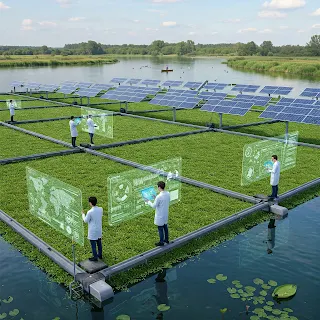In the search for sustainable solutions to global challenges, an unlikely hero has emerged—duckweed. This small aquatic plant has gained attention for its incredible ability to address food security, renewable energy production, and climate change mitigation. With its rapid growth rate, high protein content, and exceptional carbon-absorbing properties, duckweed presents a compelling case for large-scale cultivation and utilization. This article explores the numerous benefits of duckweed and its potential role in shaping a more sustainable future.
What is Duckweed?
Duckweed (Lemnaceae family) is a floating aquatic plant found in freshwater bodies worldwide. It consists of tiny, free-floating green leaves and has an exceptional ability to reproduce quickly, doubling its biomass in as little as 16–48 hours under optimal conditions. Duckweed thrives in nutrient-rich water, making it an ideal candidate for large-scale cultivation.
Duckweed and Food Security
1. High Nutritional Value
Duckweed is rich in proteins, vitamins, and essential amino acids, making it a viable alternative protein source for human and animal consumption. Some species of duckweed contain up to 40% protein, surpassing traditional crops like soybeans.
2. Efficient Growth and Minimal Resource Use
Unlike conventional crops, duckweed does not require soil and can be cultivated in controlled aquatic environments. It grows rapidly, utilizing wastewater or nutrient-rich ponds, making it an efficient solution for addressing food scarcity in regions with limited arable land.
3. Livestock and Aquaculture Feed
Duckweed has been successfully incorporated into livestock and aquaculture feed, providing an economical and nutrient-dense option for poultry, cattle, pigs, and fish. Studies indicate that duckweed-fed animals exhibit healthy growth rates, further reinforcing its potential as a sustainable agricultural resource.
Duckweed as a Renewable Energy Source
1. Biofuel Production
Duckweed has a high starch content, which can be converted into bioethanol, a renewable energy source. Unlike traditional biofuel crops like corn and sugarcane, duckweed grows rapidly, requires minimal land, and does not compete with food production, making it an attractive alternative for sustainable biofuel production.
2. Biogas Generation
Through anaerobic digestion, duckweed can be processed into biogas, which consists primarily of methane. This clean energy source can be used for electricity generation, heating, and transportation, reducing reliance on fossil fuels.
3. Carbon Sequestration
Duckweed efficiently absorbs atmospheric carbon dioxide and converts it into biomass, helping mitigate greenhouse gas emissions. Large-scale duckweed farms could play a significant role in carbon offset strategies.
Environmental Benefits of Duckweed
1. Water Purification and Wastewater Treatment
Duckweed absorbs excess nutrients such as nitrogen and phosphorus from water, preventing harmful algal blooms and improving water quality. This makes it an effective solution for treating wastewater from agricultural runoff and industrial processes.
2. Erosion Control and Soil Reclamation
Duckweed can help rehabilitate degraded aquatic ecosystems by stabilizing sediments and reducing soil erosion along water bodies. It also prevents the spread of invasive aquatic weeds by covering the water’s surface and limiting sunlight penetration.
3. Reducing Agricultural Waste
Duckweed can be cultivated using organic waste, including livestock manure and agricultural byproducts. By repurposing these waste streams, it reduces the environmental impact of agriculture while producing valuable biomass.
Challenges and Considerations
While duckweed offers numerous benefits, several challenges must be addressed before large-scale implementation:
Scalability: Efficient large-scale cultivation methods need further research and investment.
Regulatory Approval: Policies and regulations must be adapted to support the use of duckweed in food, feed, and biofuel applications.
Market Acceptance: Consumer perception and awareness of duckweed as a food and energy source must be improved.
Processing Technologies: Advanced methods for harvesting and processing duckweed biomass must be developed to optimize its economic potential.
The Future of Duckweed-Based Sustainability
Research and pilot projects worldwide are exploring ways to harness duckweed's full potential. Countries like the Netherlands, China, and the United States have initiated studies on its viability for large-scale food and biofuel production. With increasing investments in sustainable agriculture and renewable energy, duckweed could become a key player in the global green economy.
Conclusion
Duckweed is more than just a tiny aquatic plant—it is a powerful tool for addressing some of the most pressing challenges facing our planet. From enhancing food security and producing biofuels to purifying water and capturing carbon, duckweed's applications are vast and promising. By investing in research and sustainable practices, we can unlock the full potential of this remarkable plant, paving the way for a greener, more sustainable future.

No comments:
Post a Comment